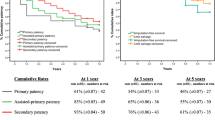Abstract
Acute and subacute ischemia of the legs in acute and subacute femoropopliteal bypass occlusion is a dramatic situation that endangers the survival of the limbs, depending on the severity of the ischemia. Different therapy options like percutaneous mechanical thrombectomy procedures, which include rotational thrombectomy, have become available in recent years in addition to local lysis and surgical thrombectomy. Rotational thrombectomy with the Straub Rotarex® System as an endovascular therapy option has demonstrated promising results leading to amputation-free survival in multiple studies. We recently provided data of 22 patients with acute femoropopliteal bypass occlusion where we examined the feasibility of the Rotarex® System in this indication. A technical success rate of 82 % was demonstrated. During a follow-up period of 6 months, no reinterventions in these patients had to be performed. We now provide patency rates in 21 patients of our study group after a follow-up period of 12 months. The average ABI after 12 months was 0.80 ± 0.1. One patient showed a hemodynamic restenosis in a Nitinolstent distal to the femoropopliteal bypass which was implanted in the index procedure. No reocclusion of the femoropopliteal bypasses occurred in all patients.





Similar content being viewed by others
References
Ouriel K, Shortell CK, De Weese JA, et al. A comparison of thrombolytic therapy with operative revascularization in the initial treatment of acute peripheral arterial ischemia. J Vasc Surg. 1994;19:1021–30.
The STILE Trial: results of a prospective randomized trial evaluating surgery versus thrombolysis for ischemia of the lower extremity. Ann Surg. 1994;220:251–66.
Ouriel K, Veith FJ, Thrombolysis or Peripheral Arterial Surgery (TOPAS) Investigators. A comparison of recombinant urokinase with vascular surgery as initial treatment for acute arterial occlusion of the legs. N Engl J Med. 1998;338(16):1105–11.
Norgen L, Hiatt WR, Dormandy JA, et al. Inter-Society Consensus for the management of peripheral arterial disease (TASC II). Eur J Vasc Endovasc Surg. 2007;33:S1–75.
Lichtenberg M. Percutaneous mechanical thrombectomy by means of rotational thrombectomy. Current Study situation. Medizinische Klinik. 2010;105:705–10.
Wissgott C, Kamusella P, Richter A, Klein-Weigel P, Steinkamp HJ. Mechanical rotational thrombectomy for treatment thrombolysis in acute and subacute occlusion of femoropopliteal arteries: retrospective analysis of the results from 1999 to 2005. Fortschr Röntgenstr. 2008;180:1–7.
Zeller T, Frank U, Bürgelin K, Müller C, Flügl P, Horn B, Schwarzwälder U, Neumann FJ. Early experience with a rotational thrombectomy device for treatment of acute and subacute infra-aortic arterial occlusions. J Endovasc Ther. 2003;10:322–31.
Zeller T, Frank U, Bürgelin K, Schwarzwälder U, Horn B, Flügl P, Neumann F. Long-term results after recanalization of acute and subacute thrombotic occlusions of the infra-aortic arteries and bypass-grafts using a rotational thrombectomy device. Fortschr Röntgenstr. 2002;174:1559–65.
Duc SR, Schoch E, Pfyffer M, et al. Recanalisation of acute and subacute femoropopliteal artery occlusions with the rotarex catheter: one year follow-up, single center experience. Cardiovasc Intervent Radiol. 2005;28:603–10.
Lichtenberg M, Kaeunicke M, Hailer B. Percutaneous mechanical thrombectomy for treatment of acute femoropopliteal bypass occlusion. Vasc Health Risk Manag. 2012;8:283–9.
Wissgott C, Kamusella P, Richter A, Klein-Weigel P, Schink T, Steinkamp HJ. Treatment of acute femoropopliteal bypass graft occlusion: comparison of mechanical rotational thrombectomy with ultrasound-enhanced lysis. Fortschr Röntgenstr. 2008;180:547–52.
Neumayer Ch, Panhofer P, Nanobashvili J, Polterauer P. Therapeutic options on femoral artery occlusion: indications, techniques and results—a vascular surgeons view. Z Gefäßmed. 2005;2(3):4–11.
Author information
Authors and Affiliations
Corresponding author
Rights and permissions
About this article
Cite this article
Lichtenberg, M., Stahlhoff, W., Boese, D. et al. Twelve months outcome after percutaneous mechanical thrombectomy for treatment of acute femoropopliteal bypass occlusion. Cardiovasc Interv and Ther 28, 178–183 (2013). https://doi.org/10.1007/s12928-012-0152-x
Received:
Accepted:
Published:
Issue Date:
DOI: https://doi.org/10.1007/s12928-012-0152-x




